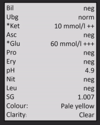Infection and immunity - Clinical medicine Flashcards
When should a urinalysis be done?
- When a UTI is suspected
- Diabates
- Screening of pregnancy
- Suspected renal disease
a) What are the 3 key urinary sympoms of a UTI?
b) What should you do if a patient has 1/3 symptoms?
c) What should you do if a patiet has 2/3 symptoms?
a) Dysuria, Nocturia, Cloudy urine
b) Urinalysis
b) Urine culture and start antibiotic
a) What issue arise when a man has symptoms suspicious of a UTI?
b) How can this issue be solved?
a) Dipstick becomes unreliable when ruling a UTI
b) A urine culture should be taken and antibiotics started
a) What type of people are dipstick uneliable in?
b) Why is this?
a) 65+ and those with catheters
b) Half of adults (more liekly as you ages) and those with catheters will have bacteria sitting around in their bladder or urine without causing an infection. This is known as asymptomatic bacteriuria
What is the cut off age for dipstick urianalysis?
65 years
What may a dark urine suggest?
Dehydration
What may red ringed urine suggest?
- Blood (haematuria)
- Drugs e.g.,fampicin (antibiotic)
- Certain foods (e.g., beetroots)
What may brown urine suggest?
- Bile pigments (e.g., jaundice)
- Myoglobin (protein) (e.g., rhabdomyolysis)
- Some antimalarial medication e.g., chloroquine
What may green/blue urine suggest?
Medications such as amitriptyline
What may cloudy urine suggest?
Pyuria (pus in the urine) – infection, renal stones
What may frothy urine suggest?
Proteinuria (nephrotic syndorme)
What may sweet swelling urine suggest?
- Diabetic ketoacidosis (DKA)
- Glycosuria (diabetes mellitus)
What may unpleasant urine suggest?
UTI
What may the present of glucose in urine suggest?
- Diabetes mellitus
- DKA
- Cushing’s disease
- Some diabetic medications (e.g., SGLT2 inhibitors)
What may the presence of bilirubin in urine suggest?
- Haemolytic disease
- Liver damage (e.g., from hepatitis)
What may blood (haematuria) in urine suggest?
- Infection
- Tauma
- Renal disease
- Enlarged prostate
- Contamination with menstrual blood
- Cancer
What should you investigate for if a patient has asymptomatic haematuria?
Cancer
What may the presence of protein (proteinuria) suggest?
- Infection
- Renal disease
What may the presence of leukocytes in urine suggest?
UTI
What may the presence of ketones in urine suggest?
- DKA (Ketones in combination with glucose – DKA, must be ruled out),
- Starvation
- Pregnancy
What may the presence of nitrates in urine suggest?
- Gram-negative YTI
- Gall bladder disease/obstruction
- Haemolysis
What may a high specifc gravity of urine suggest?
- Dehydration
- Urinating glucose &/or protein
What may a low specific gravity suggest?
- Diuretic use
- Renal disease
- Diabetes insipidus
What may an acidic pH suggest?
- Uric acid
- Kidney stones






